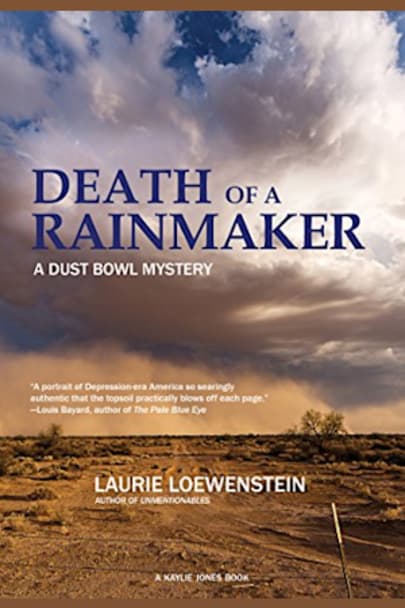“Set in Vermillion, Okla., in 1935, this superb series launch from Loewenstein…beautifully captures the devastation of the land and people in the Dust Bowl.”–Publishers Weekly, STARRED review
“Loewenstein movingly describes the events and the people, from farm eviction auctions and hobo villages to Dish Nights at the movies. She vividly brings to life a town filled with believable characters, … filled with believable characters, from a young woman learning her own worth to the deputy sheriff figuring out where his loyalties lie. This warm and evocative novel captures a time and place, with well-researched details shown through the lives and circumstances of one American town.”
—Kirkus Review
“Laurie Loewenstein’s vivid Death of a Rainmaker is at once an engrossing yarn, an elegant inquiry into human desperation, and a portrait of Depression-era America so searingly authentic that the topsoil practically blows off each page.”
—Louis Bayard, author of The Pale Blue Eye
“Reading Death of a Rainmaker is like slipping through time right into a 1930s black-and-white movie. Suddenly you live in Jackson County, Oklahoma during the Dust Bowl, and you know what the cinema, hardware store, and courthouse look like. The townspeople are your family, and you care so deeply about what happens to them that you can’t tear your eyes from the pages of this book. It’s odd for a story about a murder to be gentle and generous, but this one is. I fell in love with everyone in town–except of course those who turned out to be trouble. Laurie Loewenstein has a knack for writing the early twentieth century. I sure hope this is a series, because I’m smitten.”
—Robin Oliveira, author of The Winter Sisters
“As if the black blizzards of the Dust Bowl weren’t worrisome enough for an Oklahoma sheriff and his spunky wife, in Death of a Rainmaker Laurie Loewenstein piles on even more troubles: a murder victim’s corpse buried in a sandstorm, an array of possible perpetrators, a small community already fractured by secrets and swirls of distrust, and a contentious election in which the sheriff’s honesty and competence are on the ballot. Like the storms themselves, the plot powers its way across the landscape and seeps into everything it encounters.”
—Dayton Duncan, author of The Dust Bowl
When a rainmaker is bludgeoned to death in the pitch-blackness of a colossal dust storm, small-town sheriff Temple Jennings shoulders yet another burden in the hard times of the 1930s Dust Bowl. The killing only magnifies Temple’s ongoing troubles: a formidable opponent in the upcoming election, the repugnant burden of enforcing farm foreclosures, and his wife’s lingering grief over the loss of their eight-year-old son.
As the sheriff and his young deputy investigate the murder, their suspicions focus on a teenager, Carmine, serving with the Civilian Conservation Corps. The deputy, himself a former CCCer, struggles with remaining loyal to the corps while pursuing his own aspirations as a lawman.
When the investigation closes in on Carmine, Temple’s wife, Etha, quickly becomes convinced of his innocence and sets out to prove it. But Etha’s own probe soon reveals a darker web of secrets, which imperil Temple’s chances of reelection and cause the husband and wife to confront their long-standing differences about the nature of grief.
more


